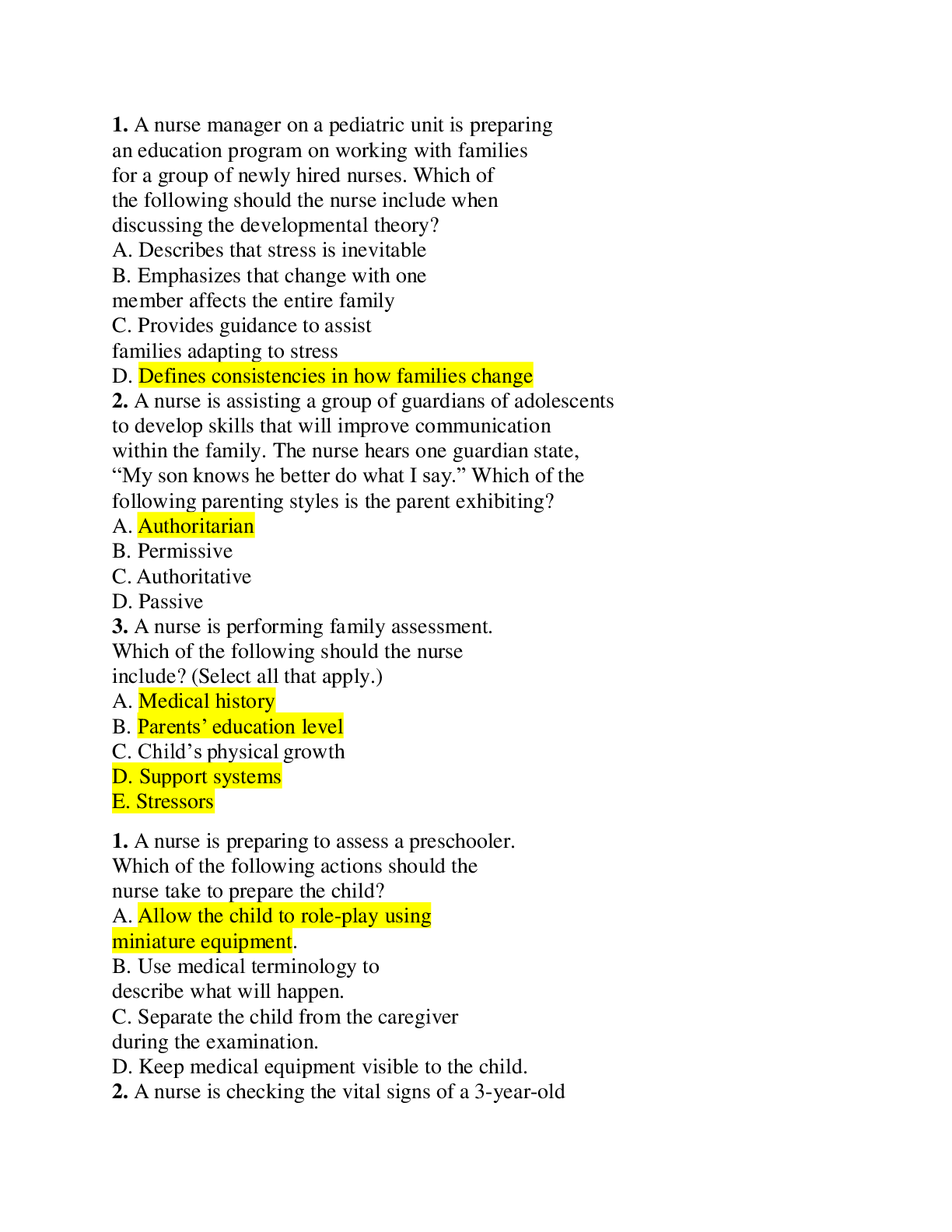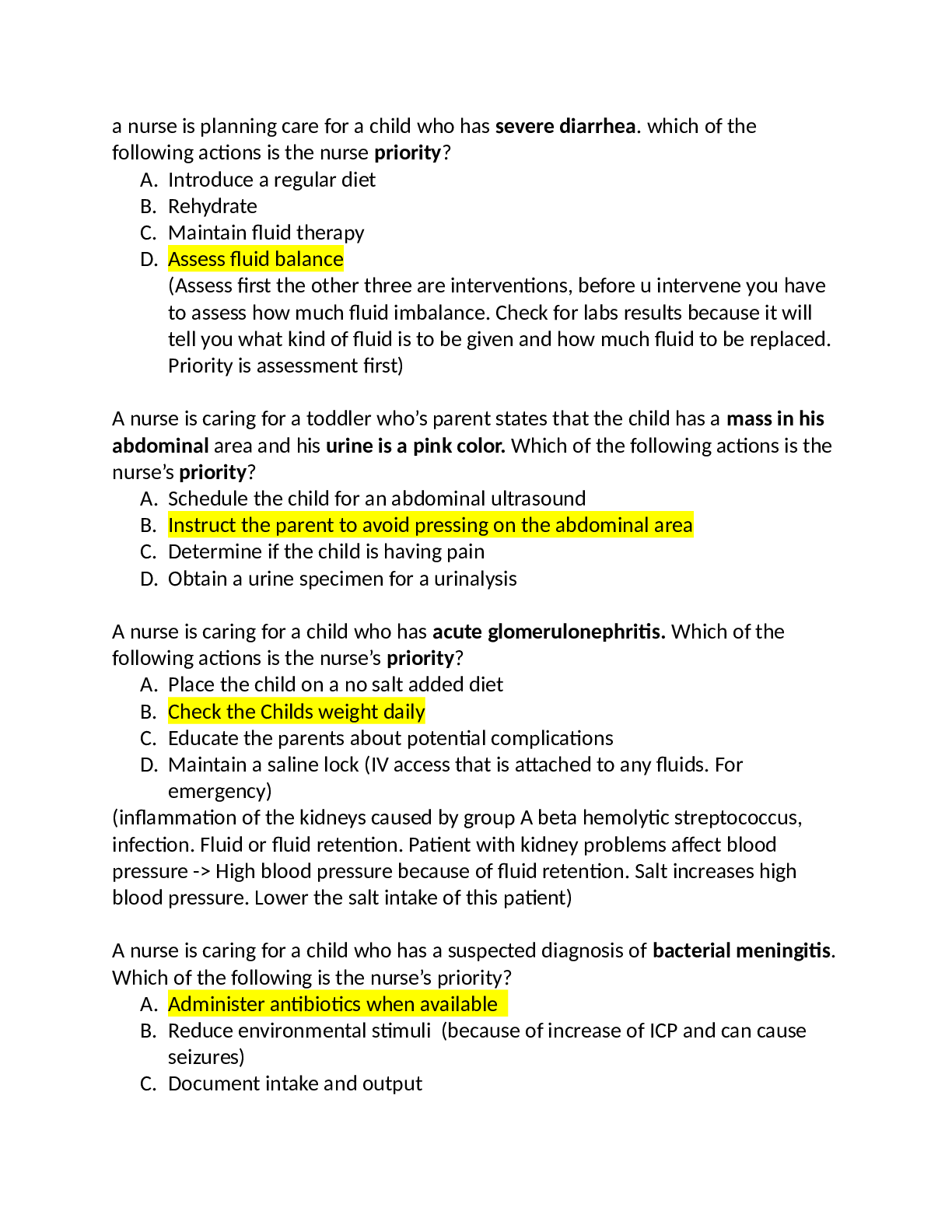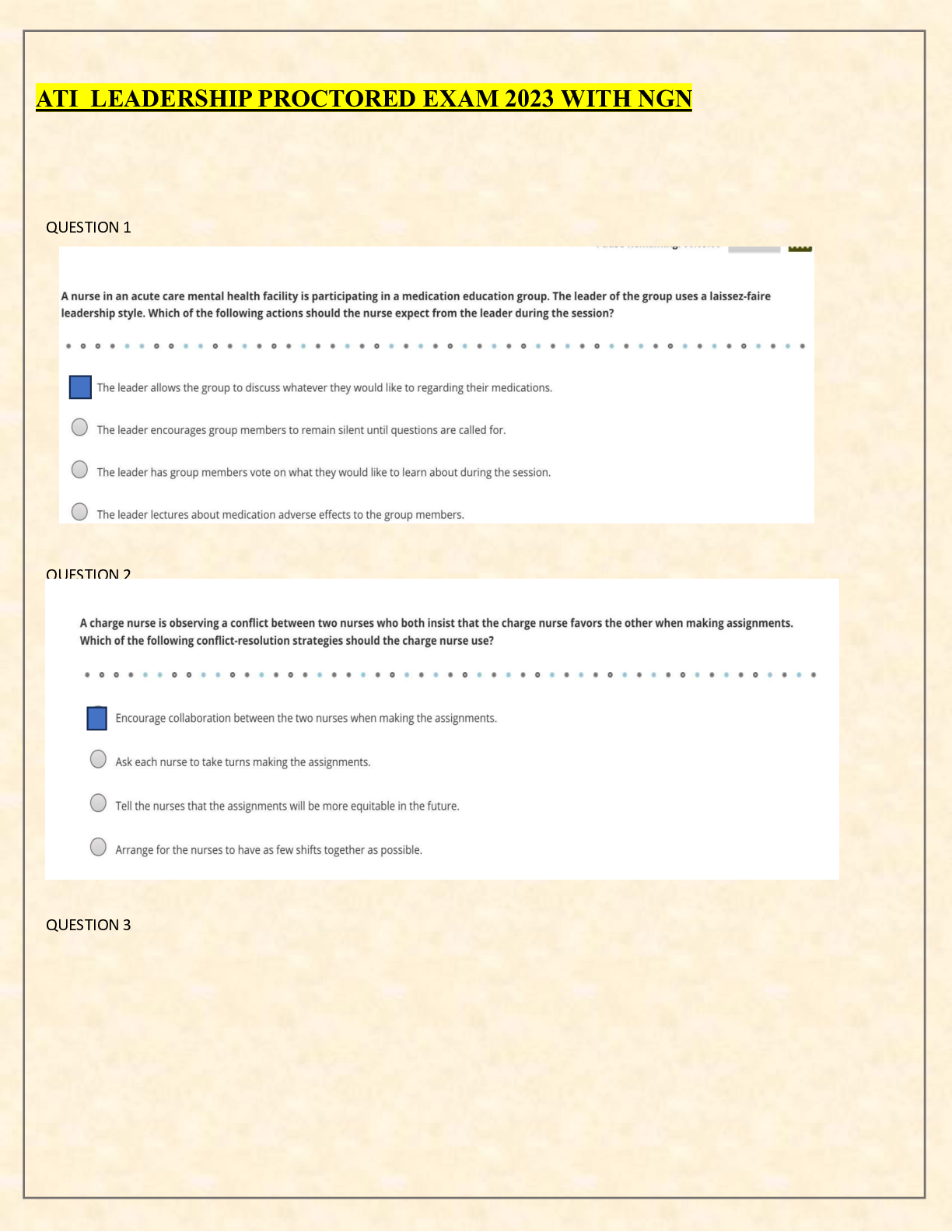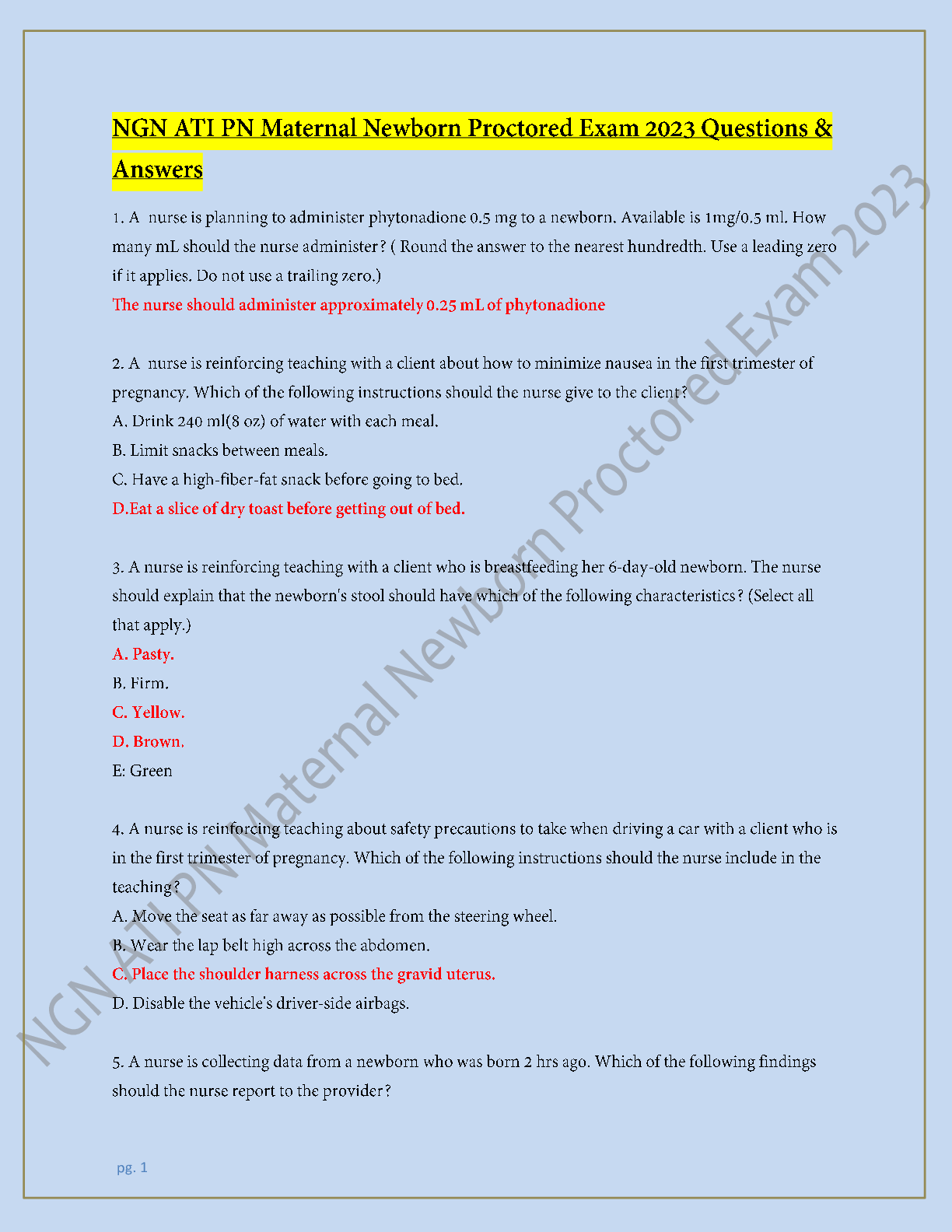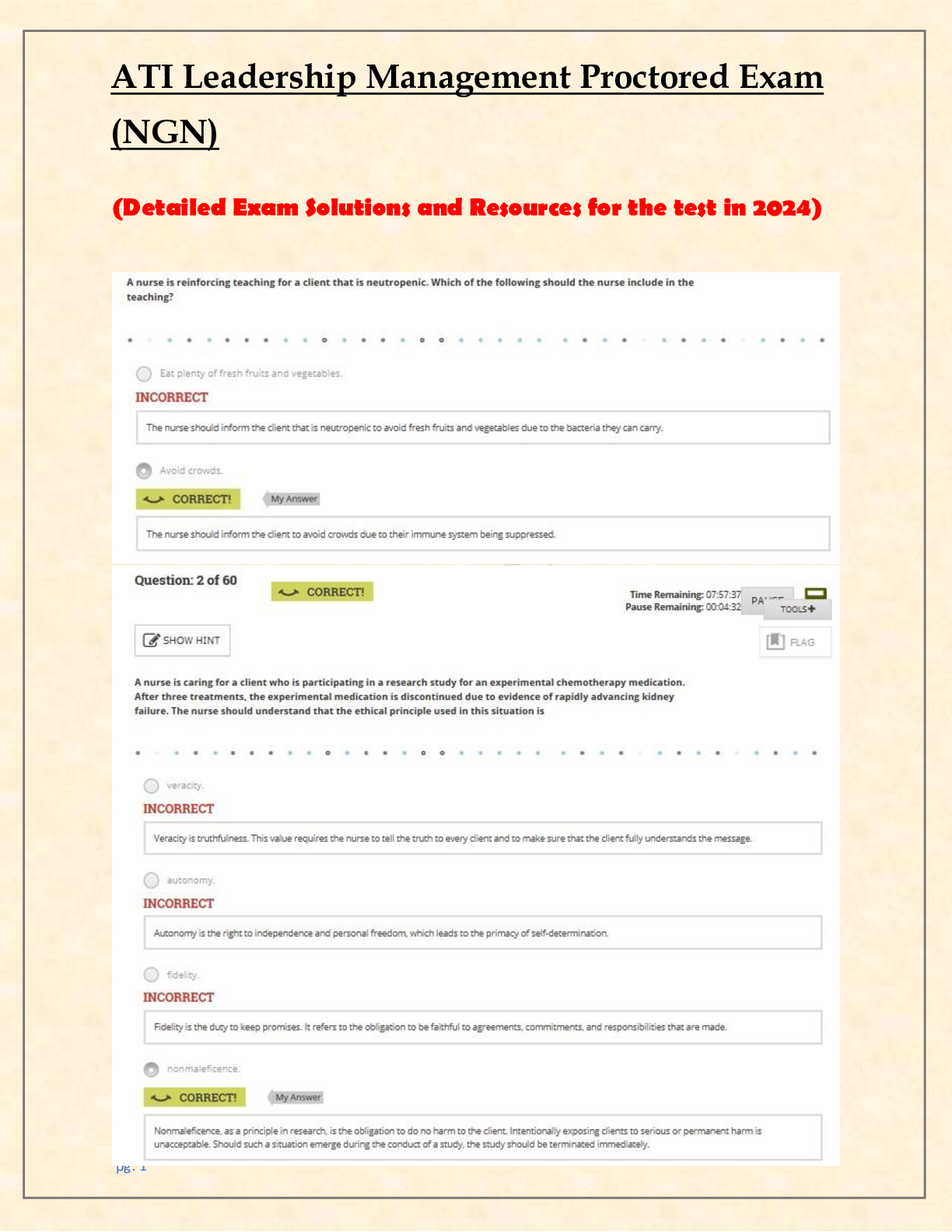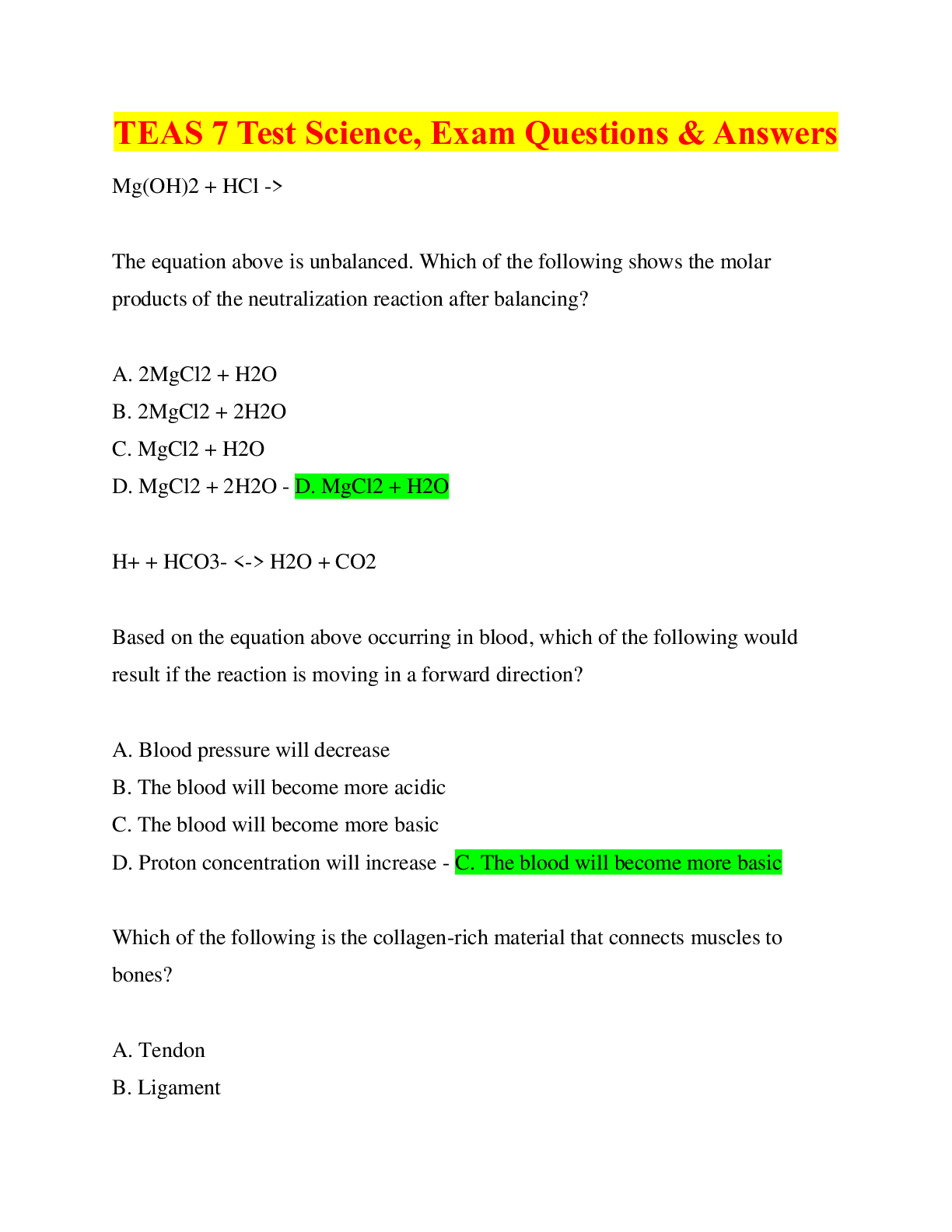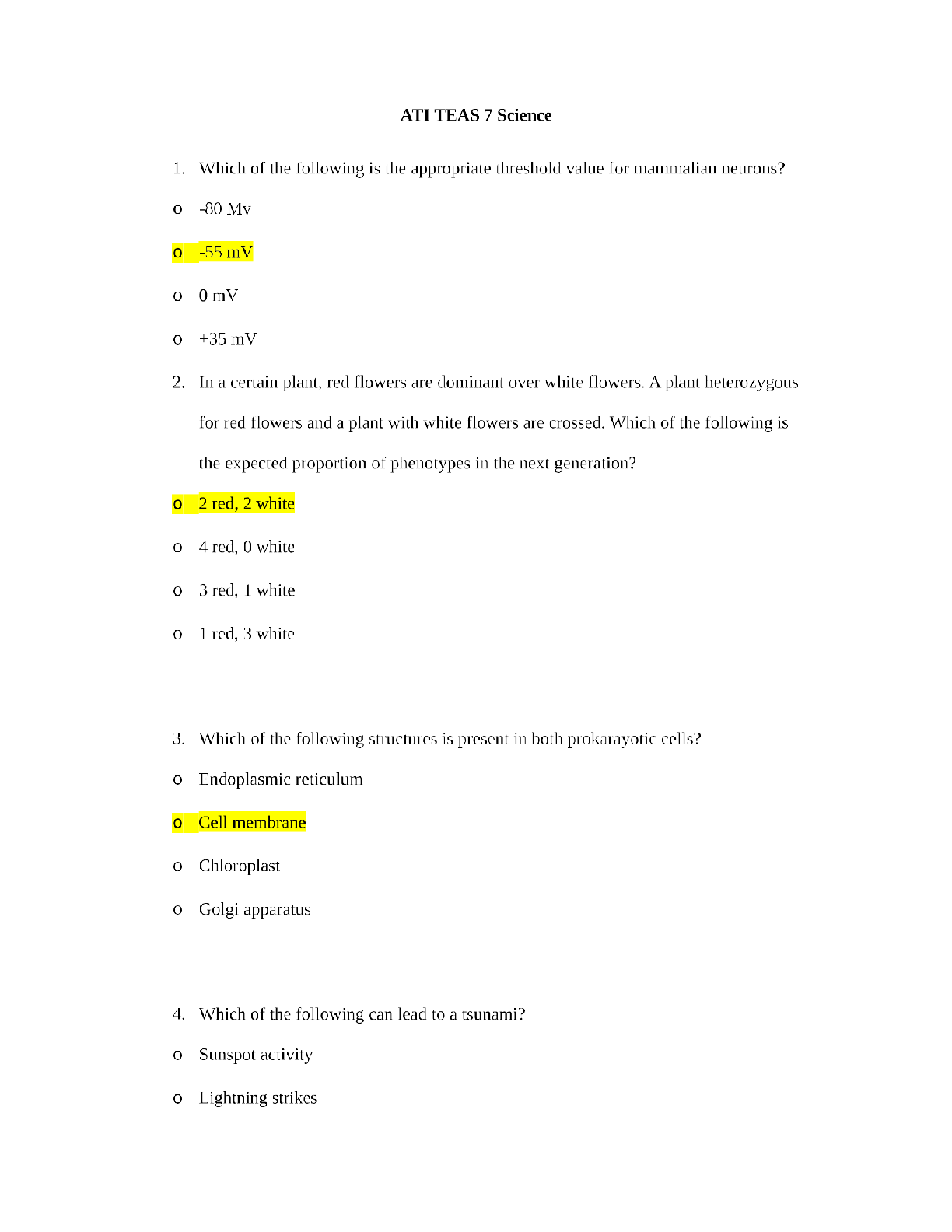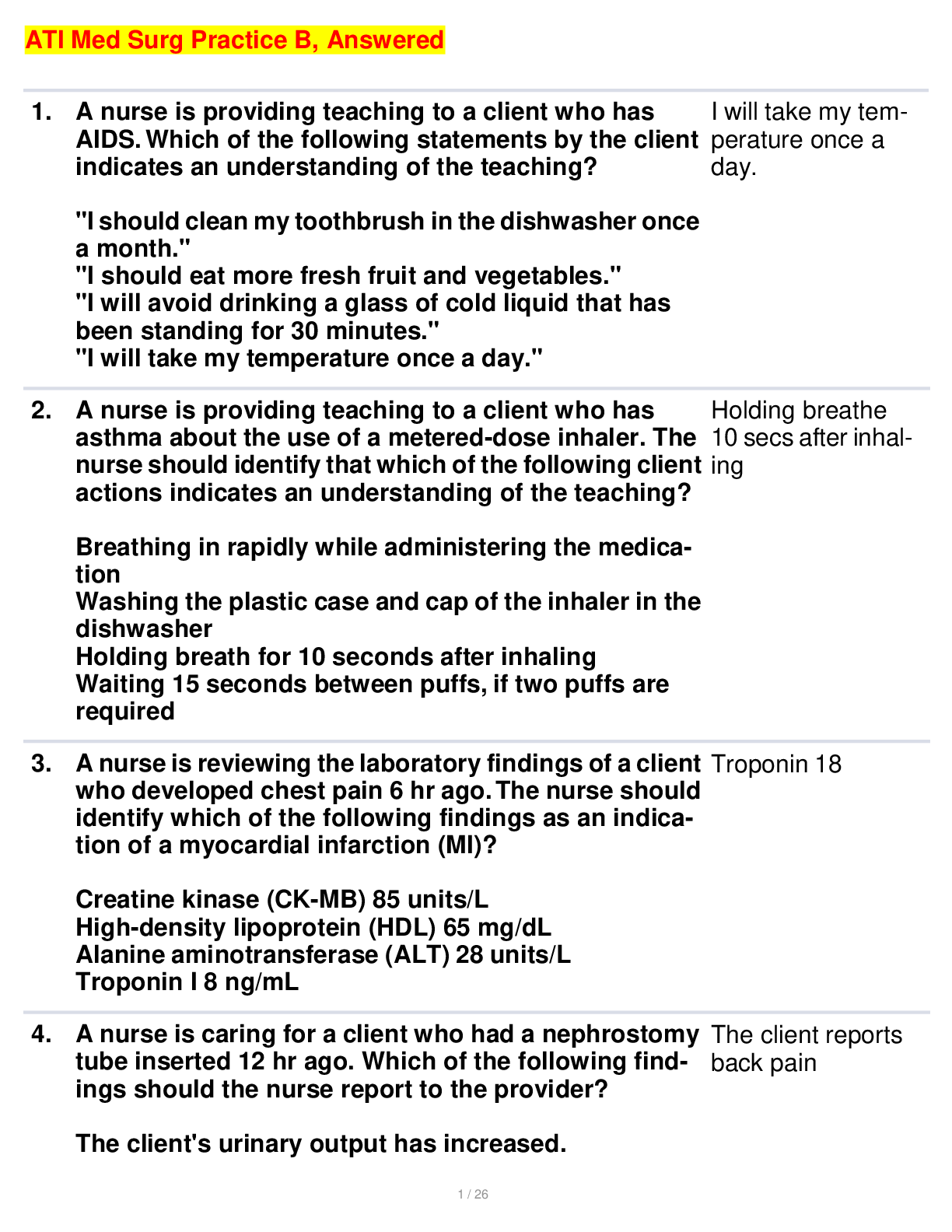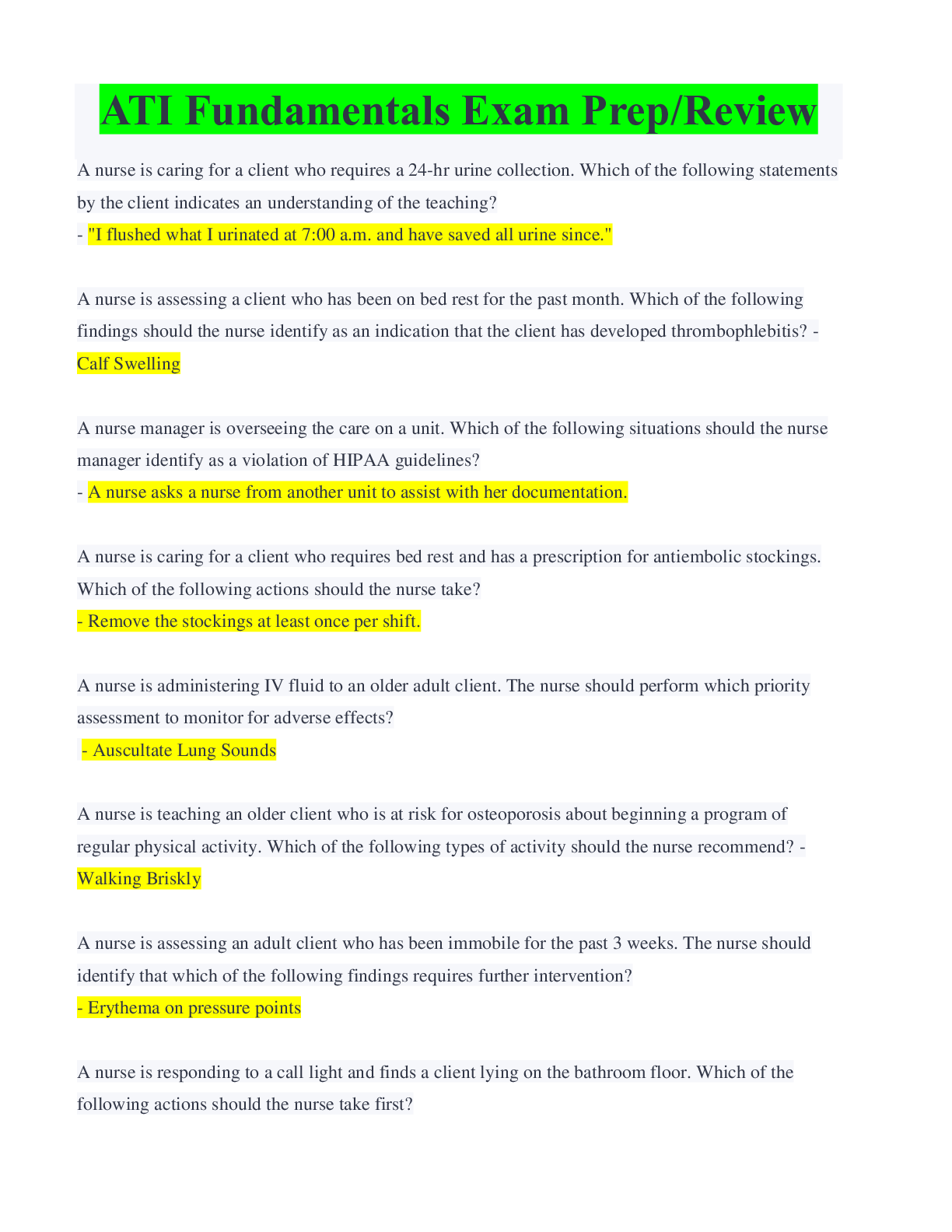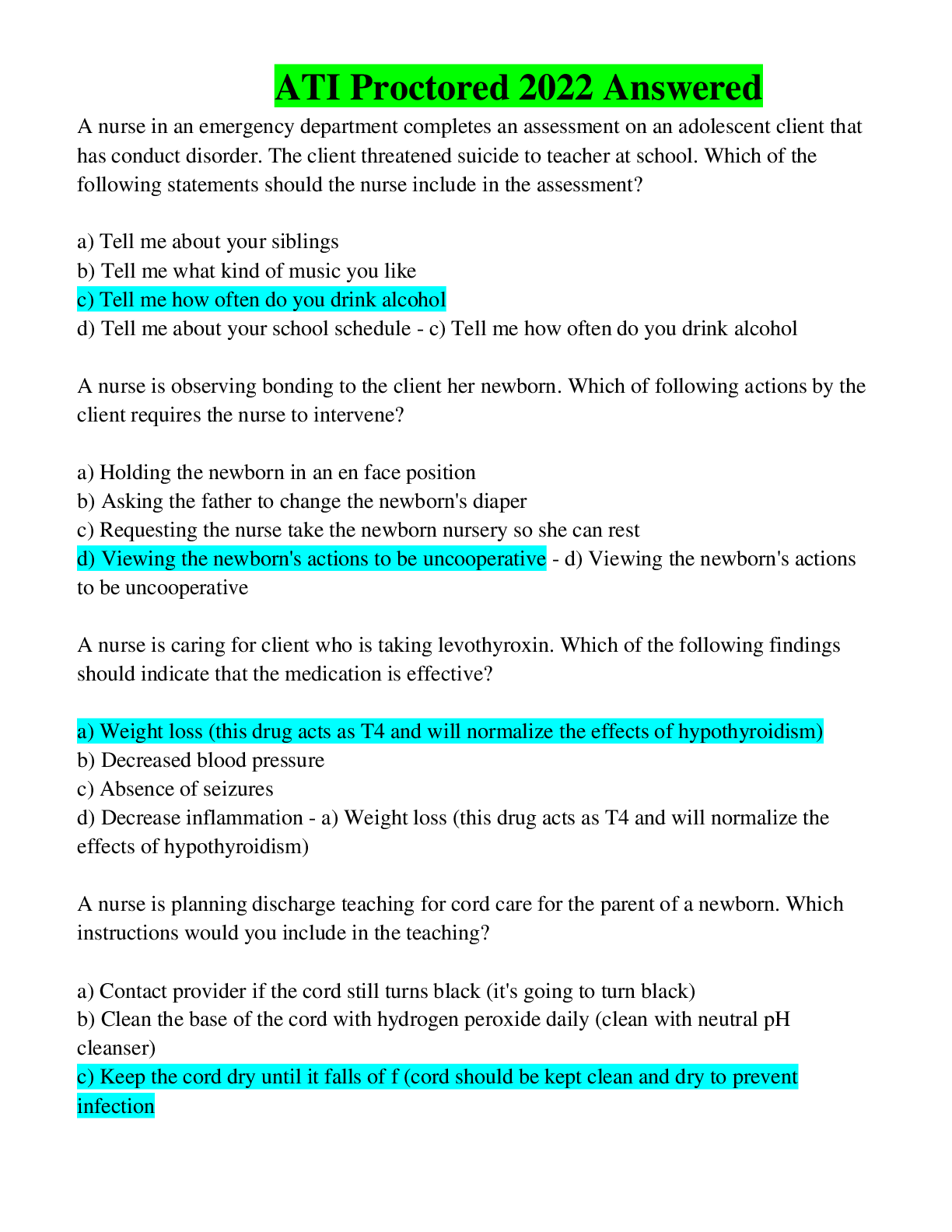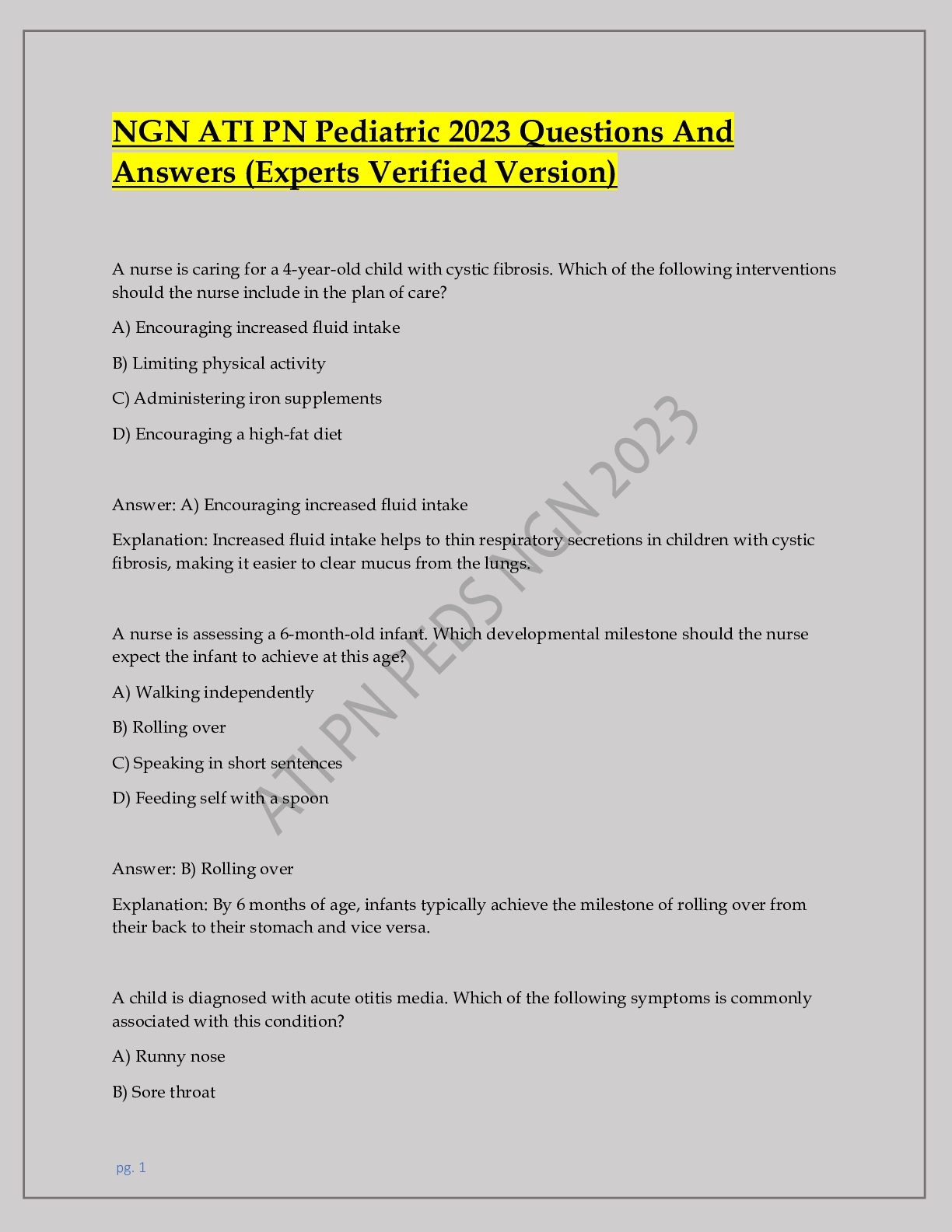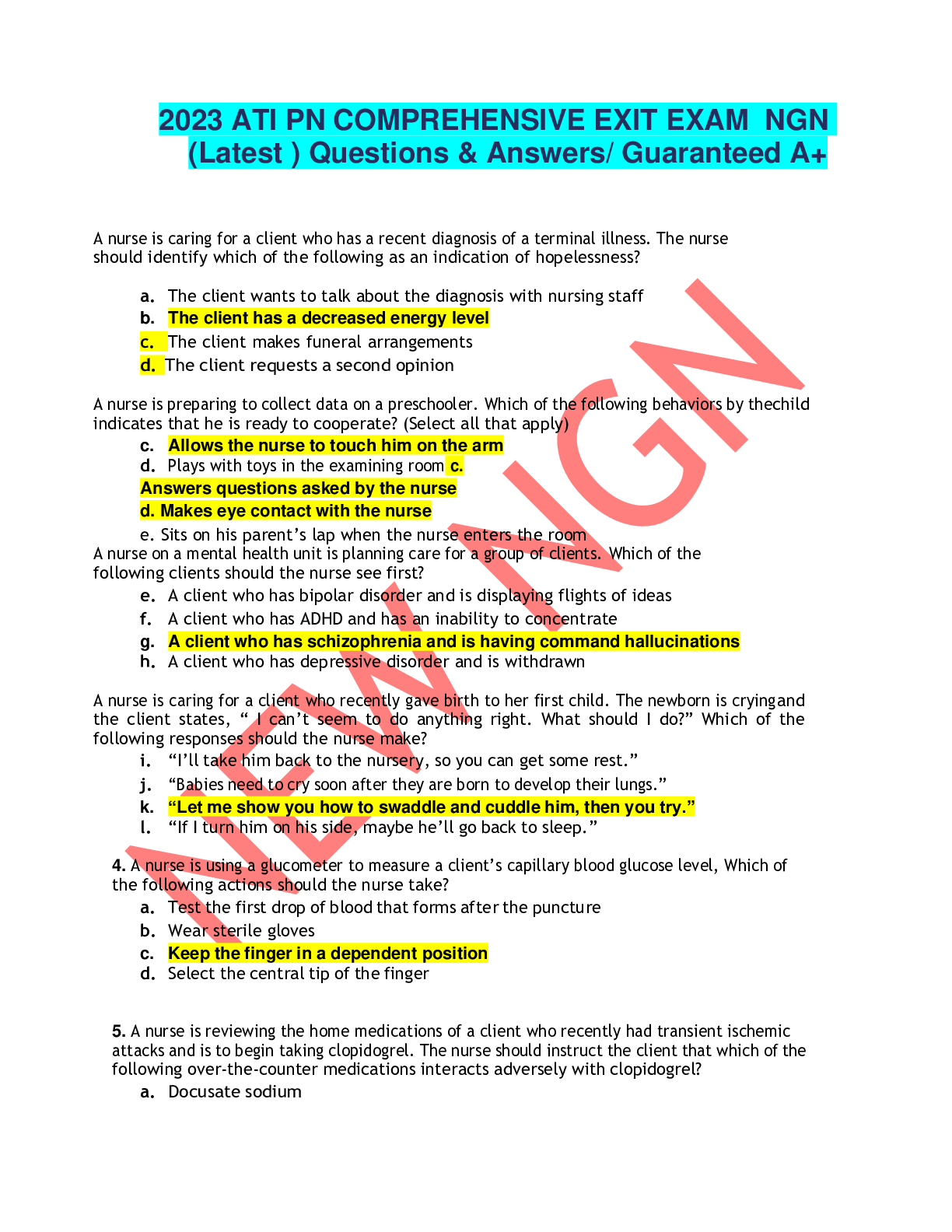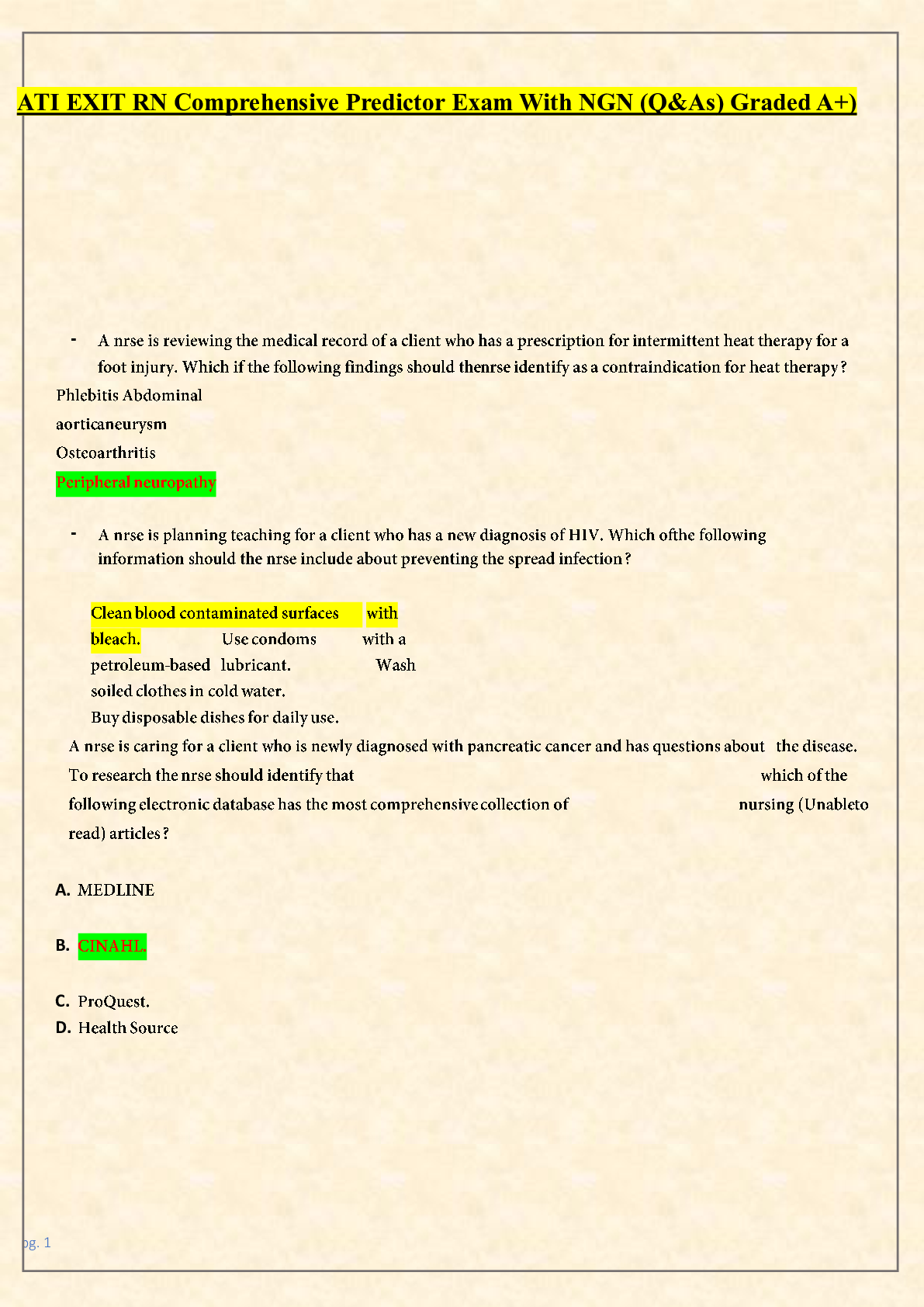ATI Pharmacology Pre-Assessment Quiz (RATED A) | 100% CORRECT SOLUTIONS
Document Content and Description Below
Pharmacology Pre-Assessment Quiz A client has been prescribed metoclopramide. Which of the following should the nurse include in client education regarding this medication? Select one: a. Notify ... your provider if you experience restlessness or spasms of the face or neck. An adverse effect of Reglan is extrapyramidal symptoms. The client should stop the medication and notify the provider if these occur. b. This medication can cause urinary frequency. c. Decrease your fluid intake while taking this medication. d. This medication can cause insomnia. A 52-year-old client with a history of angina has been prescribed transdermal nitroglycerin. Which of the following adverse effects is not seen with this therapy? Select one: a. Headache b. Orthostatic hypotension c. Tolerance d. Productive cough Correct – Nitroglycerin therapy does not directly have an effect lung function. Physiologically, vasodilation should effect capillary perfusion and decrease lung secretions. A nurse is caring for a client prescribed montelukast. Which of the following should the nurse include in teaching related to this medication? Select one: a. Advise client to take the medication once daily at bedtime. Clients should take montelukast once daily at bedtime. b. If the client forgets to take the medication for a few days he can double up on doses to catch up. c. Avoid dairy products while taking this medication. d. This medication is for acute management of asthma A nurse is caring for a client prescribed ferrous sulfate for the treatment of anemia. Which of the following instructions should be included in client teaching about this medication? Select one: a. Take the medication on an empty stomach to maximize absorption. The nurse should instruct the clients to take iron on an empty stomach, such as 1 hr before meals to maximize absorption. Stomach acid increases absorption. If GI adverse effects occur, the client can take with food to increase adherence to therapy even though absorption is also decreased. b. Take prescribed antacids at the same time as this medication. c. Decrease dietary fiber intake while taking this medication. d. Notify your provider if your stool becomes dark green. A nurse is caring for a client who has diabetes and a new prescription for 14 units of regular insulin and 28 units of NPH insulin subcutaneously at breakfast daily. What is the total number of units of insulin that the nurse should prepare in the insulin syringe? 42 Units Each order of for units of insulin is combined in the same syringe. The nurse should withdraw the regular insulin into the syringe first. A nurse is caring for a client receiving patient-controlled analgesia (PCA). Which of the following interventions should the nurse take while caring for this client? Select one: a. Increase client's 4-hr limit as needed. b. Encourage the client to use the PCA before dressing changes. The nurse should encourage the client to use the PCA prophylactically prior to activities that are likely to augment pain levels. c. Advise the client to use the pump sparingly to prevent addiction. d. Encourage the client's family to administer PCA while client is sleeping. A nurse is reviewing the medication class, benzodiazepines. The nurse would use caution when administering benzodiazepines to which of the below clients? Select one: a. A client with insomnia. b. A client with renal failure. c. A client with hypertension. d. A client with glaucoma. Correct – benzodiazepines can increase intraocular pressure due to the pupil-dilating effects of the Medication. A client has been prescribed lisinopril. Which of the following medication interactions should the nurse instruct this client about? Select one: a. Escitalopram b. Potassium supplements Correct. Potassium supplements and potassium-sparing diuretics increase the risk of hyperkalemia in clients taking ACE inhibitors such as lisinopril. Clients should only take potassium supplements if prescribed by the provider. Clients should also avoid salt substitutes that contain potassium. c. Magnesium supplements d. Ciprofloxacin A client has been prescribed vasopressin for the treatment of diabetes insipidus. What is the expected pharmacological action of this medication? a. To stimulate the pancreas to secrete insulin. b. To increase blood pressure. c. To slow the absorption of glucose in the intestine. d. To increase reabsorption of water in the renal tubules. The expected pharmacological action is to promote reabsorption of water within the kidney A nurse is caring for a client receiving a dopamine infusion via a peripheral IV. Which of the following actions should the nurse take if the IV site appears infiltrated? Select one: a. Apply a warm compress to the site. b. Apply a cold compress to the site. c. Slow the infusion and continue to monitor the site. d. Stop the infusion. Correct. If infiltration is suspected, the infusion should be stopped. Necrosis can occur from extravasation of high doses of dopamine. Extravasation can be treated with local injection of an alpha- adrenergic blocking agent, such as Phentolamine. A nurse is caring for a client newly prescribed doxazosin mesylate. Which of the following instructions should the nurse include in client education regarding taking the first dose of this medication? Select one: a. There is no need to avoid normal activities. b. Change positions slowly and lie down if dizziness occurs. First-dose orthostatic hypotension can occur with Cardura. The nurse should instruct clients to change positions slowly and to lie down if feeling dizzy, lightheaded or faint. c. Do not eat green leafy vegetables. d. Avoid dairy products while taking this medication A nurse have provided education to a client regarding prescribed levothyroxene sodium. What of the following client statements demonstrates understanding of medication administration? Select one: a. "I should take my medication as needed to alleviate symptoms." b. "I should take the medication on a full stomach." c. "I should take the medication in the morning to prevent insomnia." Synthroid should be taken once in the morning to preventinsomnia. d. "I should take the medication in divided doses to ensure therapeutic drug levels." A 55-year-old client has levothyroxine ordered. Which of the below past medical history concerns may contraindicate with her medication management of hypothyroidism? Select one: a. Peripheral Vascular Disease b. Osteoporosis Correct: There is an increased risk for fractures, especially in older adults. c. Asthma d. Scleroderma A nurse is preparing to administer an intramuscular injection to an adult client. At what angle should the nurse administer the medication using the ventrogluteal site? Select one: a. a 45 degree angle b. A 90 degree angle IM injections should be administered at a 90 degree angle. c. a 75 degree angle d. a 60 degree angle A nurse has just administered a wrong medication to a client. Which of the following actions should the nurse take next? Select one: a. Report error to the provider. Correct. The nurse should acknowledge the error and report it to the provider for further orders. The nurse should also monitor the client for adverse effects. b. No action is needed. c. Complete an institutional incident report. d. Inform the client that the wrong medication was given. A 45-year-old client is taking methylprednisolone. What pharmacological action should the nurse expect with this therapy? Select one: a. Suppression of airway mucus production. Correct – Corticosteroids, such as methylprednisolone (Solu-Medrol) will suppress airway mucus production. b. Suppression of candidiasis. c. Fortification of bones. d. Suppression of beta receptors. Before administering blood products, which action should be taken? Select one: a. Prime IV tubing with 0.45% sodium chloride. b. Administer epinephrine. c. Document client response. d. Assess the client’s temperature. Correct: Assess the client’s vital signs, obtain consent for the procedure and ensure compatibility. Prime the IV tubing with 0.9% sodium chloride. The nurse would not document client response or administer epinephrine prior to starting the transfusion. A client has been prescribed isosorbide mononitrate. Which of the following should the nurse include in this client's education related to this medication? Select one: a. You can crush this medication if needed. b. Take an additional tablet if you experience chest pain. c. This medication is prescribed for long-term prophylaxis against anginal attacks. Isosorbide mononitrate (Imdur) is used forlong-term prophylaxis against anginal attacks. d. Take the medication in the evening after dinner. A nurse is caring for a client prescribed the HMG CoA reductase inhibitor, atorvastatin. Which of the following should be monitored while this medication is prescribed? Select one: a. Hearing screenings b. Visual acuity screenings c. Renal function tests d. Liver function tests Correct. Statins (HMG CoA reductase inhibitors) like atorvastatin (Lipitor) can cause hepatotoxicity. Prior to initiating therapy the client's baseline liver function should be determined then liver function tests should be checked after 12 weeks of therapy and then every 6 months. The nurse should advise the client to observe for symptoms of liver dysfunction (anorexia, vomiting, nausea, jaundice) and to notify the provider if these occur. A nurse is caring for a client prescribed hydromorphone for severe pain. The client's respiratory rate has decreased from 16 breaths per minute to 6. Which if the following medications should the nurse prepare to administer? Select one: a. Naloxone Correct. This client is experiencing respiratory depression likely related to over administration of hydromorphone (Dilaudid). Naloxone (Narcan) and nalmefene (Revex) are opioid antagonists used to reverse an overdose of opioids. b. Flumazenil c. Aluminum hydroxide d. Activated charcoal A nurse is caring for a client prescribed digoxin. Which the following should alert the nurse to possible digitalis toxicity? Select one: a. anorexia and weakness Correct. Anorexia, fatigue and weakness are signs of potential digitalis toxicity. GI effects of digitalis toxicity include anorexia, nausea, vomiting and abdominal pain. CNS effects include fatigue, weakness, vision changes (diplopia, blurred vision, yellow-green or white halos around objects). Bradycardia is also commonly noted in digitalis toxicity. b. tachycardia and increased urination c. hyperactivity and hunger d. polyphagia and polydipsia A nurse is caring for a client who is prescribed warfarin therapy for an artificial heart valve. Which of the following laboratory values should the nurse monitor for a therapeutic effect of warfarin? PT (Prothrombin time) This test is used to monitor warfarin therapy. For a client receiving full anticoagulant therapy, the PT should typically be approximately two to three times the normal value, depending on the indication for therapeutic anticoagulation. A nurse is preparing to administer 10 units of regular insulin and 20 units of NPH insulin to a client. What is the sequence of events the nurse should follow? • Inspect vials for contaminants: With the exception of NPH insulin, all insulin available today is supplied as a clear, colorless solution. Do not use insulin that is colored, cloudy, or has formed a precipitate. The first step is to observe the characteristics of the regular and NPH insulin to determine whether they are safe to use. • Roll NPH vial between palms of hands: Because NPH insulin is a suspension, the particles must be evenly dispersed by rolling the vial gently between the palms of the hands. This should be done gently because vigorous mixing may cause the solution to become frothy and cause inaccurate dosing. If granules or clumps are present after mixing, discard the solution. This should be done prior to withdrawing the solution into the syringe. • Inject air into NPH insulin vial: This creates a pressure in the vial for accuracy in measuring the amount prescribed. • Inject air into regular insulin vial: The amount of air injected into the vial of short-acting insulin is equal to the amount to be administered. • Withdraw short-acting insulin into syringe: When the prescription requires the administration of two types of insulin, it is preferable to mix the solutions into one syringe if they are compatible to prevent the client from receiving two injections. Of the longer-acting insulin available, only NPH insulin is mixed with short-acting insulin. When two insulins are to be mixed, withdraw the short-acting insulin first to avoid contaminating the stock vial with NPH insulin. • Add intermediate insulin to syringe: The mixture is stable for 28 days. A client is prescribed propranolol. Which of the following client history findings would require the nurse to clarify this medication prescription? Select one: a. Tachydysrhythmias b. Asthma Correct. Clients with asthma should avoid Beta2 Blockade agents such as propranolol. Bronchoconstriction can occur. Clients with asthma should be administered a beta1selective agent. c. Hypertension d. Urolithiasis Which of the following are contraindications to aspirin therapy? Select all that apply. Select one or more: a. Coronary artery disease b. Deep vein thrombus c. Thrombocytopenia Correct. Aspirin is contraindicated in clients with bleeding disorders and thrombocytopenia. d. Third trimester pregnancy Correct. Aspirin is pregnancy risk category D in the third trimester. e. Adolescents with chickenpox Correct. Aspirin should not be given to children or adolescents with fever or recent chickenpox due to the risk of Reye syndrome. A nurse is preparing to administer a bisacodyl (Dulcolax) 10 mg suppository. Which of the following are correct administration guidelines for the nurse to implement? (Select all that apply.) Don sterile gloves is incorrect. The nurse should wear clean gloves for the procedure. Gloves prevent the transmission of pathogens by direct and indirect contact. The nurse should wear clean gloves when touching blood, body fluid, secretions, excretions, most mucous membranes, nonintact skin, and contaminated items or surfaces. Lubricate index finger is correct. The rounded end of the suppository is lubricated with a sterile water-soluble lubricating jelly. Use a rectal applicator for insertion is incorrect. The nurse should administer the suppository with the dominant index finger, which is lubricated. The nurse should not use an applicator to insert a suppository. Position client supine with knees bent is incorrect. To avoid the rupturing the rectum, the client is positioned on the left lateral side. Insert suppository just beyond internal sphincter is correct. The nurse should gently retract the buttocks with the nondominant hand. Insert the suppository gently through the anus, past the internal sphincter, and against the rectal wall. Following the administration of the medication, the nurse should apply gentle pressure to hold the buttocks together momentarily if needed to keep medication in place. A nurse is providing care to a client with staphylococcus epidermidis, who is prescribed vancomycin. Identify the adverse effect associate with this antibiotic therapy? Select one: a. Infusion reaction Correct – Red Man Syndrome or an infusion reaction that results in rashes, flushing, tachycardia and hypotension can occur as an adverse reaction. For this reason, vancomycin should be administered over a 60 minute period. b. Immunosuppression c. Hepatotoxicity d. Constipation A nurse is preparing to administer a measles, mumps, and rubella vaccine (MMR) to an adult client. Which of the following is a contraindication to this vaccine? Select one: a. The possibility of overseas travel in the next month b. Client allergy to strawberries c. The possibility of pregnancy within 4 weeks Pregnancy or the possibility of pregnancy with 4 weeks is a contraindication to the MMR vaccine. d. Client history of genital herpes Disulfiram is taken by a client daily for abstinence maintenance. What is an adverse effect of this therapy? Select one: a. Wernicke’s aphasia b. Hepatoxicity Correct: Hepatoxicity is an adverse effect of disulfiram c. Diarrhea d. Suicidal ideations A nurse is preparing to administer morphine sulfate 2 mg IV bolus. Available is morphine sulfate 10 milligrams per milliliter. How many ML should the nurse administer per dose? (Round the answer to the nearest tenth. Use a leading zero if it applies period to not use a trailing 0) Answer is 0.2 mL Ratio and Proportion STEP 1: What is the unit of measurement the nurse should calculate? mL STEP 2: What is the dose the nurse should administer? Dose to administer= Desired 2 mg STEP 3: What is the dose available? Dose available = Have 10 mg STEP 4: Should the nurse convert the units of measurement? No STEP 5: What is the quantity of the dose available? 1 mL STEP 6: Set up an equation and solve for X. Have/Quantity = Desired/X 10 mg/1 mL = 2 mg/X mL X = 0.2 STEP 7: Round if necessary. STEP 8: Reassess to determine whether the amount to administer makes sense. If there are 10 mg/mL and the prescription reads 2 mg, it makes sense to administer 0.2 mL. The nurse should administer morphine sulfate 0. 2 mL IV bolus. Desired Over Have STEP 1: What is the unit of measurement the nurse should calculate? mL STEP 2: What is the dose the nurse should administer? Dose to administer= Desired 2 mg STEP 3: What is the dose available? Dose available = Have 10 mg STEP 4: Should the nurse convert the units of measurement? No STEP 5: What is the quantity of the dose available? 1 mL STEP 6: Set up an equation and solve for X. Desired x Quantity/Have = X 2 mg x 1 mL/10 mg = X mL 0.2 mL = X STEP 7: Round if necessary. STEP 8: Reassess to determine whether the amount to administer makes sense. If there are 10 mg/mL and the prescription reads 2 mg, it makes sense to administer 0.2 mL. The nurse should administer morphine sulfate 0. 2 mL IV bolus. Dimensional Analysis STEP 1: What is the unit of measurement the nurse should calculate? mL STEP 2: What is the quantity of the dose available? 1 mL STEP 3: What is the dose available? Dose available = Have 10 mg STEP 4: What is the dose the nurse should administer? Dose to administer= Desired 2 mg STEP 5: Should the nurse convert the units of measurement? No STEP 6: Set up an equation and solve for X. X = Quantity/Have x Conversion (Have)/Conversion (Desired) x Desired/ X mL = 1 mL/10 mg x 2 mg/ X = 0.2 STEP 7: Round if necessary. STEP 8: Reassess to determine whether the amount to administer makes sense. If there are 10 mg/mL and the prescription reads 2 mg, it makes sense to administer 0.2 mL. The nurse should administer morphine sulfate 0. 2 mL IV bolus. Pharmacology Actual Assessment 1 -A nurse is monitoring a client who received an excessive dose of morphine. Which of the following adverse effects should the nurse identify as the priority? -nausea and vomiting -urinary retention -decreased respirations -increased drowsiness -A nurse is caring for a client who has a prescription for a hypotonic IV fluid. Which of the following solutions should the nurse expect to administer? 0.45% sodium chloride 0.9% sodium chloride 3% sodium chloride Lactated ringers -A nurse is caring for a client who refuses a prescribed dose of Valproic acid 250 mg PO. The client states I don’t want to take that pill because it makes me feel nauseated. Which of the following actions should the nurse take? Select all that apply. Educate the client about the possible consequences of not taking the medication. *** Suggest the client take food with the medication to minimize GI effects. **** Document the clients refusal in the medication administration record. **** Offer to administer the medication I am. Recommend a client ask the provider to prescribe and enteric-coated medication.**** -A nurse is caring for a client who has open angle glaucoma and a new prescription for acetazolamide. Prior to administering the first dose the nurse should ask the client if they have an allergy to which of the following medication classifications? Nitrates sulfa-based medications antilipemic agents proton pump inhibitors -A nurse in an emergency department is caring for a client who has a new prescription for acetylcysteine. For which of the following conditions should the nurse expect to administer this medication? Gastrointestinal bleed acute bronchospasm morphine toxicity acetaminophen toxicity -A nurse is caring for a client who has a prescription for Terazosin. The nurse should identify that this medication is indicated for which of the following disorders? Select all that apply. Hypertension heart failure male pattern baldness benign prostatic hypertrophy erectile dysfunction -A nurse is assessing a client who reports taking spironolactone 50 mg PO twice daily for several months. For which of the following manifestations should the nurse withhold the prescribed dose of spironolactone and notify the provider? Muscle weakness BUN 15 mg/DL gynecomastia BP 118/78 -A nurse is providing teaching for a client who has a new prescription for oral metronidazole. Which of the following teaching points is the priority for the nurse to include? You should report a rash to your provider. You should take the medication with food or milk if you experience gastrointestinal upset. You might have a metallic taste in your mouth while taking this medication. Your urine might become brownish in color while taking this medication. -A nurse in an intensive care unit is caring for a client who has a sudden onset of sustained supraventricular tachycardia SVT. Which of the following medication should the nurse plan to administer? Atropine enalapril lidocaine adenosine -A nurse is preparing to administer verapamil to a client who is 2 days post myocardial infarction. The nurse should monitor the client for which of the following outcomes as a therapeutic response to the medication? Increased heart rate increased blood pressure decreased pulmonary congestion decreased anginal pain -A nurse is reviewing laboratory results prior to administering ketorolac to a client. Which of the following findings should the nurse report to the provider prior to administration? Sodium 140 MEQ/L creatinine 1.6 MG/DL aspartate aminotransferase AST 33 units/L lactic acid 6 mg/DL -A nurse is assessing a client who has heart failure and is taking digoxin. Which of the following manifestations should the nurse report to the provider as an indication for digoxin toxicity? Vomiting dilated pupils bruising peripheral edema -A nurse is providing teaching to a client who has neuropathic pain and a new prescription for optyline once per day. Which of the following information should the nurse include in the teaching? Increase fluids while taking the medication. Expect an elevation in blood pressure with initial doses of the medication. Stop the medication immediately if urine becomes orange in color. Take the medication in the morning. -A nurse is providing teaching to a client who has a new prescription for transdermal nitroglycerin patches to treat angina pectoris. Which of the following instructions should the nurse include in the teaching? Remove the patch for 2 to 4 hours daily. Cover the patch with plastic wrap. Apply a new patch each day after waking up. Replace the existing patch with a new patch as soon as angina pain begins. c or d ???? look up ******** -A nurse is teaching a partner of a client who has diabetes mellitus how to manage episodes of severe hypoglycemia when the client is unresponsive. Which of the following actions should the nurse instruct a partner to take first? Administer glucagon IM to the client. Call emergency medical services. Check the client's blood glucose level. Transport a client to the emergency department. Could be A or B?? Look up******* -A nurse is caring for a client who has HIV and is starting therapy with ritonavir and zidovudine. The client asked why must they take both medications. Which of the following responses should the nurse make? If you take the two medications together it will shorten the duration of your antiviral therapy. Taking the two medications together keeps you from becoming resistant to either of them. Taking the two medications together keeps you from developing toxicity from either of them. zidovudine will help protect you from the possible adverse effects of right on ritonavir. -A nurse is caring for a client who refuses a prescribed influenza immunization. Which of the following actions should the nurse take first? Contact the provider who prescribed the immunization. Ask the client to describe their concerns. Provide the client with education about the immunization. Document the client's refusal of the immunization. -A nurse is preparing to administer a second unit of packed red blood cells RBCs to a client who is experiencing hemorrhagic shock. The nurse should monitor the client for which of the following manifestations as an indication of circulatory overload? Chills wheezing dyspnea flushing -A nurse is caring for a client who has a new prescription for our lost citron. Which of the following therapeutic effects should the nurse expect the client to experience? A decrease in the amount of gastric acid production. A decrease in the frequency of defecation. An increase in gastric motility. An increase in the absorption of water into the intestines. -A nurse is caring for a client who has recurrent lower urinary tract infections UTI. Which of the following medications should the nurse expect to administer? Ganciclovir Amphotericin B Azithromycin Nitrofurantoin -A nurse is reviewing medical records for a group of clients. Which of the following findings should the nurse report to the provider? A client who is taking citalopram and has a prolonged QT interval. A client who is taking duloxetine and has an alanine transaminase ALT of 32 units/L. A client who is taking fluoxetine and has gained 1 kg (2.2 pounds) over 12 weeks. A client who is taking carbamazepine and has a platelet count of 320,000/MM3 -A nurse is caring for a client who has a prescription for vancomycin 1 g IV intermittent infusion over 30 minutes every 12 hours. Which of the following actions should the nurse take? Request a serum trough level blood draw for 60 minutes after completion of infusion. Change that infusion site after each dose administration. Contact the provider for prescription clarification. Request a serum peak level to be drawn 30 minutes prior to infusion. -A nurse is providing teaching to a client who has a new prescription for folic acid. The client states I thought that was only given during pregnancy. Which of the following statements should the nurse make? Folic acid is important for stimulating the immune system. Folic acid is given to increase the absorption of other medications. Folic acid is administered to minimize the manifestation of benign prostatic hyperplasia. Folic acid is important for the building of blood cells. -A nurse is caring for a client who is receiving a continuous intravenous infusion of heparin. The nurse should expect to administer which of the following medications if the client experiences acute heparin toxicity? Vitamin K physostigmine protamine calcium gluconate -A nurse is planning care for a client who has neutropenia. Which of the following medications should the nurse expect to administer? Epoetin Filgrastim Enoxaparin Oprelvekin -A nurse is teaching a client who has asthma about using a beclomethasone inhaler along with an albuterol inhaler. Which of the following instructions should the nurse include about beclomethasone inhaler? You should gargle with water after each use of this inhaler. There is no need to use a spacer for this inhaler. You should use this inhaler for any acute incident of shortness of breath. Use the beclomethasone inhaler before using your albuterol inhaler to increase absorption. -A nurse is providing teaching to a client who has a new prescription for levothyroxine. Which of the following statements by the client indicates an understanding of the teaching? I should take this medication with food. I will take three doses each day. I might not realize the full effect of the medication for several weeks. I might gain weight while taking this medication if I do not exercise. -A nurse is reviewing the medical record of a client who receives medications one hour ago and reports having chest pain. The nurse should recognize that chest pain can be an adverse effect of which of the following medications? Albuterol Furosemide Digoxin Atenolol -A nurse is teaching a group of newly licensed nurses about the prevention of medication errors. Which of the following factors should the nurse identify as the most frequent cause of fatal medication errors? Incorrect packaging such as a topical medication packaged as an oral medication. Delivery device problems such as an infusion pump malfunction. Name confusion between two medications with similar sounding names. Incorrect labeling of a medication dispensed by the pharmacy. -A nurse is planning a staff education session about adverse effects of medications. Which of the following information should the nurse include when discussing the adverse effects of anticholinergic medications? Select all that apply. Blurred vision polyuria productive cough tachycardia constipation 30. A nurse is planning a staff education session about adverse effects of medications. Which of the following information should the nurse include when discussing the adverse effects of anticholinergic mediations? Select all a) Blurred vision---correct b) Polyuria c) Productive cough d) Tachycardia---correct e) Constipation---correct 31. A nurse is providing teaching to a client who has Parkinson’s disease and has a new prescription for carbidopa/ levodopa. Which of the following instructions should the nurse include in the teaching? a) Stop taking the medication if your urine becomes dark b) Take this medication at the first sign of tremors c) Increase you intake of foods high in protein d) Move slowly when you stand up---correct 32. A nurse is caring for a client who has osteoporosis and a new prescription for raloxifene. Which of the following should the nurse assess prior to initiating therapy? a) CBC results b) Family history of colon cancer c) Thyroid function d) Pregnancy status---correct 33. A nurse is providing teaching to a client who has type 2 diabetes mellitus and is starting to take immediate-release exenatide. Which of the following client statements indicates an understanding of the teaching? a) “I will discard the open injector pen after two months” b) “I will inject the medication into the muscle of my thigh” c) “I will store open injector pens at room temperature” d) “I will take this medication one hour before morning and evening meals”--- correct 34. A nurse is teaching a client who has a new prescription for brimonidine to treat open- angle glaucoma. Which of the following client statements indicated an understanding of the teaching? a) “It’s okay to put the drops in my eyes while Im weaing my contacts” b) “I can expect to feel some irritation when I put these drops in my eyes”--- correct c) “I should expec to stop taking the medication after 3 weeks” d) “At least these drops will help clear up the redness I get in my eyes sometimes” 35. While assessing a client at the beginning of the shift, a nurse notes that the client received a medication in error from the nurse on the previous shift. At which of the following times should the nurse plan to complete an incident report about the error? a) After the end of the current shift b) After contacting risk management---Nikki thinks it could also be this c) As soon as the assessment is complete---Nikki put this d) As soon as the nurse from the previous shift has been informed 36. A nurse is providing teaching to a client who has a new prescription for oral extended-release potassium chloride tablets. Which of the following instructions should the nurse include in the teaching? a) “do not crush this medication”---correct b) “dissolve the tablet in your mouth” c) “Take this medication on an empty stomach” d) “Take this medication every other day” 37. A nurse is providing teaching to a client who has a new prescription for ranitidine for the treatment of Zollinger-Ellison syndrome. The nurse should explain to the client that ranitidine treats ulcers through which of the following actions? a) It decreases stomach motility b) It reduces gastric acid production---Nikki thinks she put this c) It forms a protective barrier in the stomach lining d) It neutralizes gastric acid---Nikki thinks it could also be this 38. A nurse is providing teaching to a client who has a new prescription for oxybutynin. Which of the following client statements indicate an understand of the teaching? a) “I will limit my fluid intake” b) “I may continue to take my antihistamines” c) “I should eat less fiber” d) “I need to avoid jogging on warm days”---correct 39. A nurse in the PACU is caring for a client who has received general anesthesia and has manifestations of malignant hyperthermia. Which of the following medications should the nurse expect to administer? a) Diazepam b) Dantrolene c) Cyclobenzaprine d) Mextaxalone---correct 40. A nurse is caring for four clients who have peptic ulcer disease. The nurse should recognize that misoprostol is contradicted for which of the following clients? A. A client who might be pregnant---correct B A client who is experiencing diarrhea C. A client who is receiving long-term NSAID therapy D. A client who has a gastrointestinal bleed 41. A nurse is caring for a client who has varicella-zoster virus. Which of the following medications should the nurse expect to administer? A. Acyclovir---correct B. Vancomycin C. Gentamicin D. Quinine 42. A nurse is providing teaching to a client who has a new prescription for ciprofloxacin. Which of the following client statements indicate an understanding of the teaching? A. “I will stop taking this medication when I feel better.” B. “I should wear protective clothing when I go outdoor”---correct C. “I should take my medication daily in the morning with milk” D. “I should stop taking my birth control pills while I’m taking this medication” 43. A nurse is preparing to administer mannitol IV to a client. The nurse should monitor the client for which of the following manifestations as an expected outcome of this medication? A. Decreased thyroxine levels B. Correction of atrial flutter C. Reduced intracranial pressure---correct D. Increased hemoglobin levels 44. A nurse is caring for a client who is experiencing respiratory depression after taking an excessive dose of oxycodone. Which of the following medications should the nurse expect to administer? A. Bisacodyl B. Naloxone - correct C. Flumazenil D. Pentazocine 45. A nurse is teaching a client who is starting subcutaneous leuprolide for the treatment of prostate cancer. Which of the following information should the nurse include in the teaching? A. Increase calcium intake – Nikki thinks it’s this B. Keep the solution cold for administration C. Monitor for low blood glucose levels D. The medication can cause constipation – Nikki says might be this… couldn’t remember what she put 46. I nurse is discussing adverse effects with a client who has non-Hodgkin’s lymphoma and is starting to take methotrexate. Which of the following information should the nurse provide? A. Methotrexate can increase the risk the bleeding ---correct B. Methotrexate can cause bradycardia C. Methotrexate can cause arthritic pain D. Methotrexate can cause insomnia 47. A nurse is providing teaching to a client who has a new prescription for montelukast. Which of the following statements by the client indicates an understanding of the teaching? A. “I will take an extra dose of this medication if I have an acute asthma attack.” B. “I can take up to four tablets per day to help control my asthma symptoms” C. “I will take this medication every day to control my exercise induced asthma” ---correct D. “I should always keep this medication with me incase I have an acute asthma attack.” 48. A nurse is reviewing the laboratory findings for a client who is taking zidovudine to treat HIV. Which of the following findings should the nurse report to the provider? A. Platelets 165,000/mm3 B. Neutrophil count 650/mm3 ---correct C. Hgb 15 g/dL D. Albumin 4 g/dL 49. A nurse is providing teaching to a client who has a new prescription for allopurinol to treat gout. Which of the following instructions should the nurse include in the teaching A. “Expect to experience a harmless rash while taking this medication” B. “Increase your fluid intake” –--Nikki chose this C. “Increase your dietary fiber intake to prevent constipation” – but this could possibly right (Per Nikki) D. “Take one dose every hour until the pain subsides” 50. A nurse is obtaining vital signs for a client who has been taking propranolol. Which of the following findings should the nurse identify as an adverse effect on the medication? A. Respiratory rate 20/min B. Oral temperature 37.8C (100.1) C. Blood pressure 118/78 mmHg D. Apical pulse 50/min ---correct Pharm assessment remediation- • pH---------7.36 (in range) so this means its compensating • PaO2 90 • PaCO2—34 (in range)---- • HCO3-----20 (below)------so this is acidosis this is bicarb • What is interpretation? o Compensated metabolic acidosis • [Show More]
Last updated: 1 year ago
Preview 1 out of 20 pages
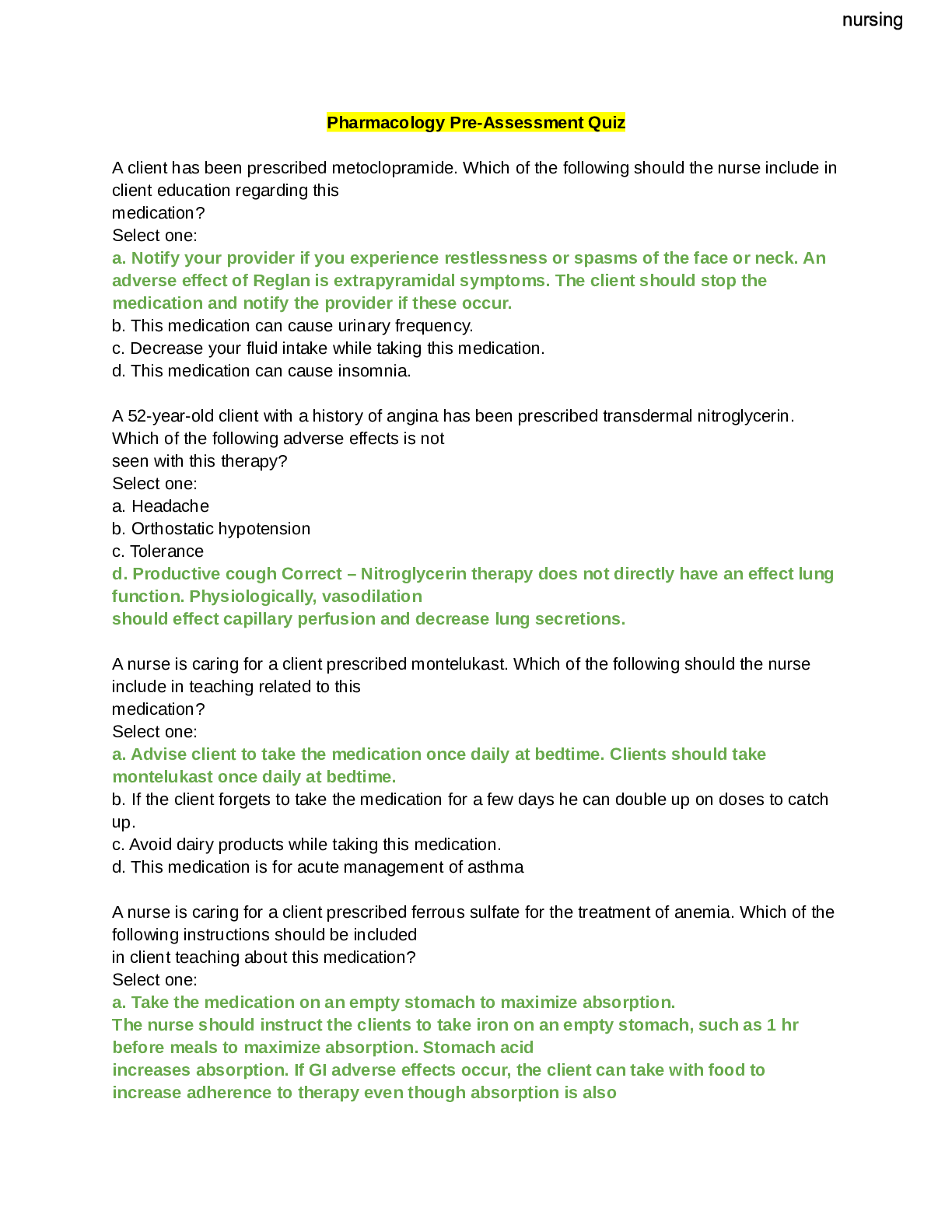
Reviews( 0 )
Document information
Connected school, study & course
About the document
Uploaded On
Jun 09, 2022
Number of pages
20
Written in
Additional information
This document has been written for:
Uploaded
Jun 09, 2022
Downloads
0
Views
19

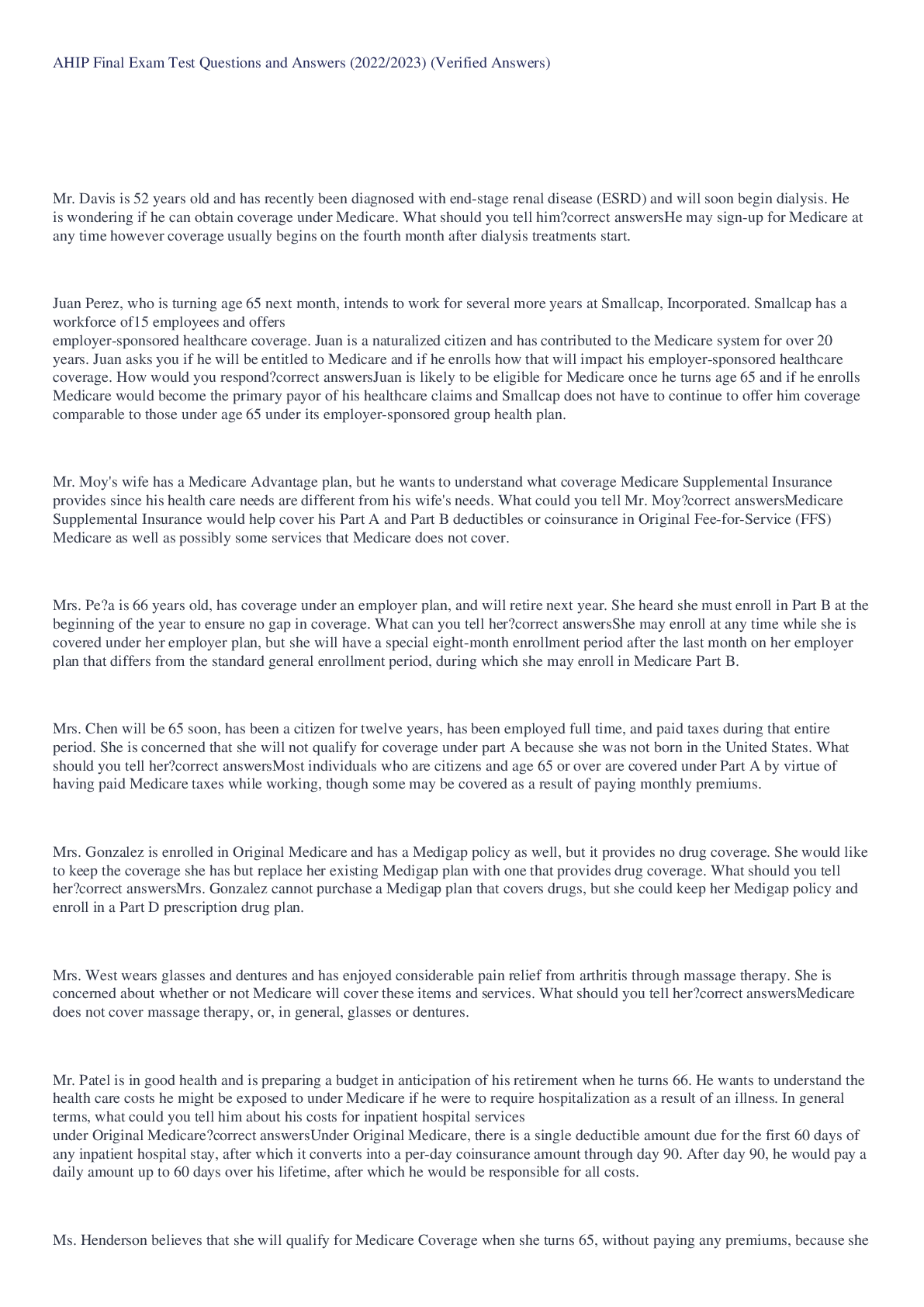

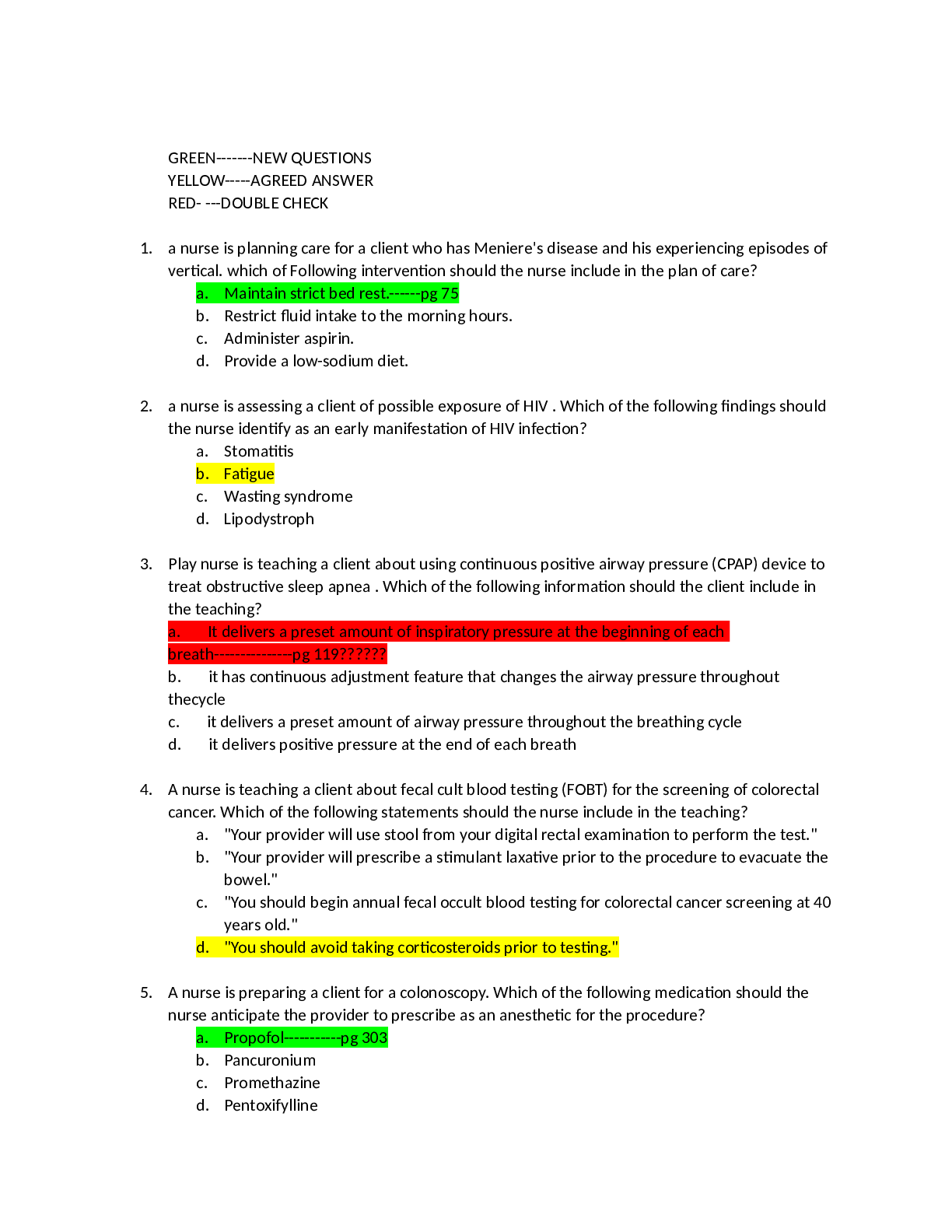



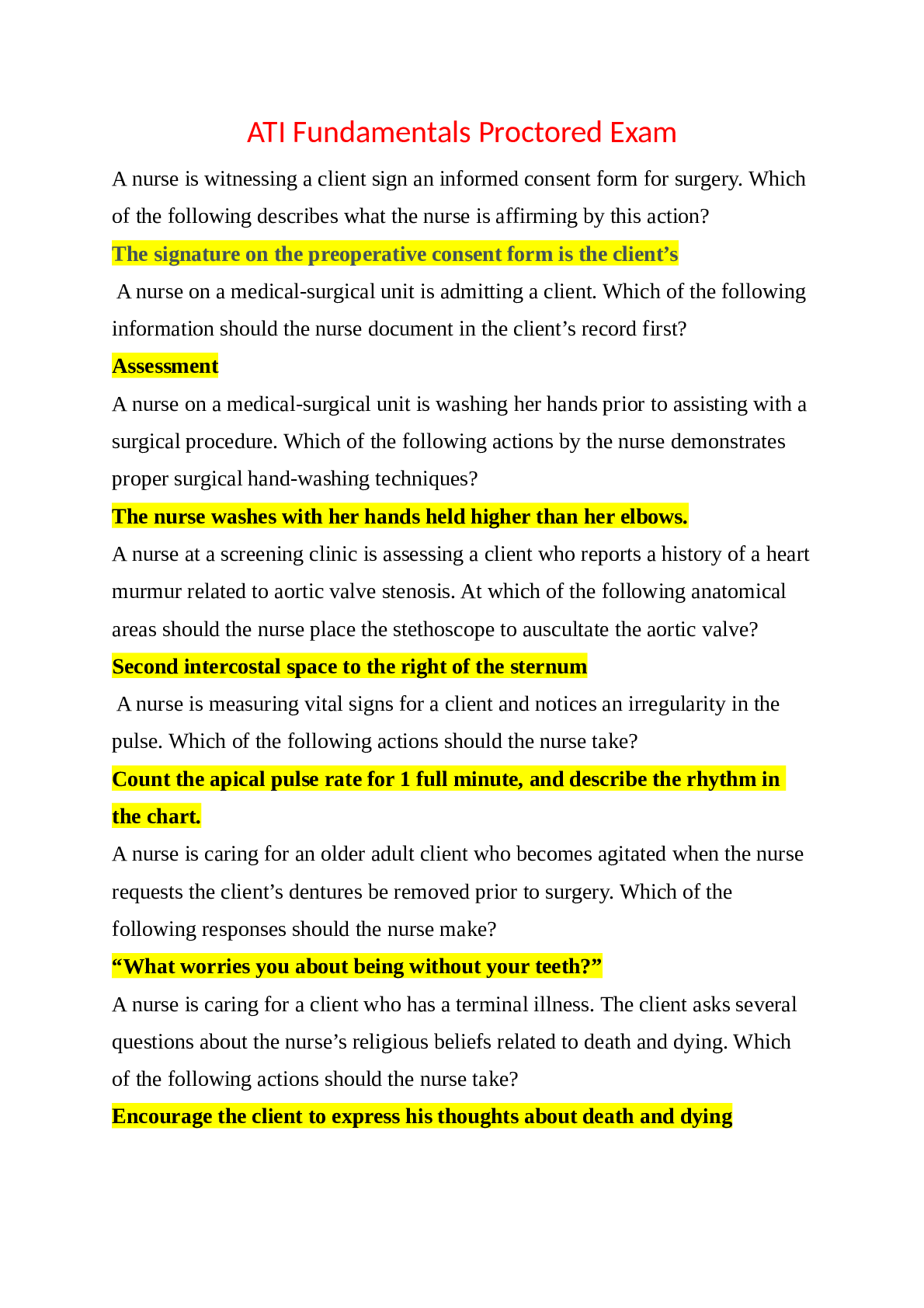



.png)

